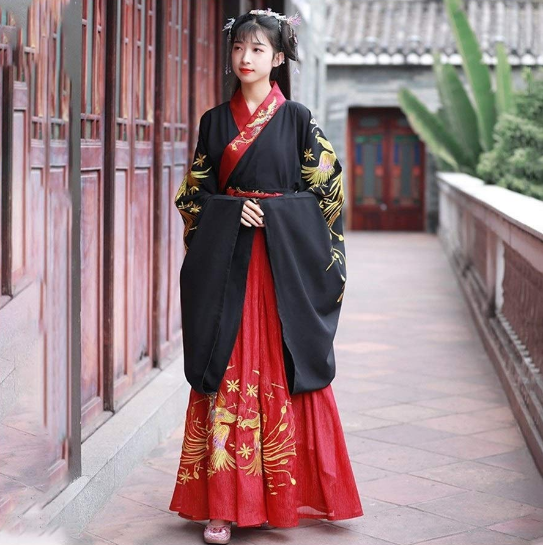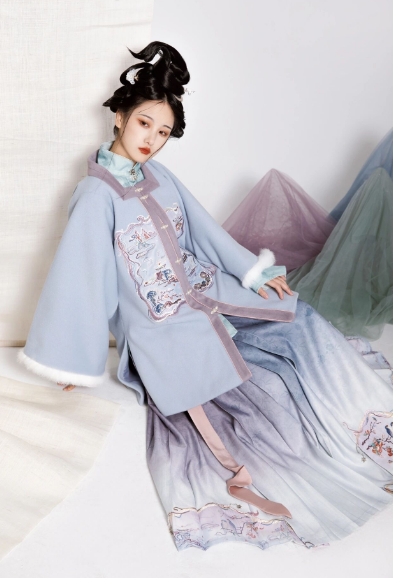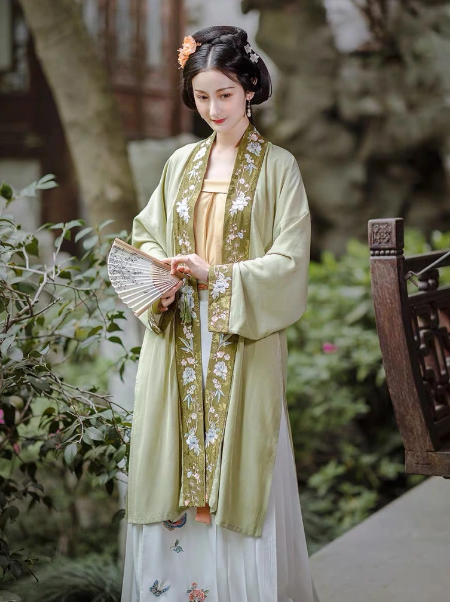Introduction
In the realm of traditional Chinese attire, Huafu and Hanfu stand as distinctive styles with rich histories. These two forms of clothing embody the cultural heritage and artistic expression of China. This introduction will provide a comprehensive overview of both Huafu and Hanfu, shedding light on their unique characteristics and cultural significance.
Definition of Huafu
Huafu, often referred to as “华服,” is a traditional Chinese clothing style that originated thousands of years ago. It is characterized by its intricate designs, vibrant colors, and luxurious materials. Huafu is typically worn during significant cultural events, such as weddings, ceremonies, and festivals. The attire’s intricate embroidery, silk fabrics, and elaborate accessories contribute to its timeless elegance. Huafu has been an integral part of Chinese culture for centuries, symbolizing grace, heritage, and sophistication.

Definition of Hanfu
Hanfu, or “汉服,” represents another prominent traditional Chinese attire. It encompasses clothing styles that were worn by the Han ethnic group, the majority in China, throughout various dynasties. Hanfu is recognized for its loose, flowing robes, distinctive sleeves, and the use of natural fabrics like silk and cotton. This attire carries profound historical significance, reflecting the social hierarchy and cultural values of ancient China. Hanfu has experienced a revival in recent years, as a growing number of enthusiasts seek to preserve and celebrate this cultural heritage.
Historical Context
Evolution of Huafu over Time
The evolution of Huafu over the centuries has been marked by significant changes in design and materials.
- Materials: Initially, Huafu was crafted from silk and precious materials, primarily available to the elite. Over time, the use of these materials expanded to a broader audience.
- Design Elements: Huafu’s design evolved, incorporating intricate embroidery, unique patterns, and vibrant colors, reflecting changes in fashion tastes.
- Dynastic Influences: Different Chinese dynasties contributed to the evolution of Huafu, influencing its style and purpose.
- Modern Adaptations: In the modern era, Huafu designs have adapted to contemporary preferences while maintaining their cultural essence.
Evolution of Hanfu over Time
Hanfu, too, has undergone significant transformations throughout its history.
- Early Hanfu: Early Hanfu was characterized by simple, loose-fitting robes made from silk or hemp. It emphasized modesty and grace.
- Dynastic Variations: Each dynasty introduced variations in Hanfu styles, with distinct sleeve lengths, collar designs, and accessories.
- Decline and Revival: Hanfu faced a decline during the Qing Dynasty but experienced a revival in the 21st century, with enthusiasts meticulously researching and recreating historical clothing.
- Modern Influences: Contemporary Hanfu designs incorporate elements from various dynastic periods while adapting to modern fashion sensibilities.
Key Characteristics
Understanding the key characteristics of Huafu and Hanfu is crucial for appreciating their cultural significance.
Distinctive Features of Huafu
Huafu’s unique attributes set it apart as a symbol of elegance and tradition.
- Materials: Huafu typically employs luxurious materials such as silk and brocade, known for their quality and sheen.
- Intricate Embroidery: Elaborate and detailed embroidery work is a hallmark of Huafu, often featuring auspicious motifs and patterns.
- Vibrant Colors: Huafu’s color palette includes rich, vivid hues like red, yellow, and blue, symbolizing prosperity and happiness.
- Formal Design: Huafu is characterized by a formal and structured design, suitable for special occasions and ceremonies.
- Accessories: Completing the ensemble are ornate accessories, including headdresses, belts, and jewelry, enhancing its regal appearance.
- Cultural Significance: Huafu embodies Confucian values of respect and propriety, making it an essential part of traditional Chinese culture.
Distinctive Features of Hanfu
Hanfu possesses its own set of distinctive features that encapsulate its historical and cultural essence.
- Loose and Flowing: Hanfu’s loose, flowing robes are comfortable and graceful, reflecting a focus on modesty and aesthetics.
- Layered Garments: Hanfu often consists of layered garments, including an outer robe and an inner layer, providing versatility in different weather conditions.
- Sleeve Styles: The sleeves of Hanfu vary in length and design, with wide, flowing sleeves being a common feature in many styles.
- Natural Fabrics: Hanfu is crafted from natural fabrics like silk and cotton, emphasizing the use of eco-friendly materials.
- Cultural Symbolism: Hanfu symbolizes cultural pride, heritage, and a connection to China’s ancient past.
- Modern Adaptations: Contemporary Hanfu designs blend historical elements with modern fashion trends, making it versatile for various occasions.
Cultural Significance
Understanding the cultural significance of Huafu and Hanfu sheds light on their roles in Chinese culture.
Role of Huafu in Chinese Culture
Huafu plays a multifaceted role in Chinese culture, encompassing various aspects.
- Symbol of Tradition: Huafu embodies centuries-old Chinese traditions, reflecting the country’s rich history and heritage.
- Ceremonial Importance: It is worn during significant life events such as weddings, graduations, and important ceremonies, signifying respect and adherence to cultural customs.
- Social Status: Historically, Huafu was associated with social hierarchy, with distinct designs and colors reserved for the elite.
- Cultural Identity: Huafu represents a sense of cultural identity and pride, strengthening the connection between individuals and their Chinese heritage.
- Artistic Expression: The intricate designs and craftsmanship of Huafu showcase Chinese artistic excellence and attention to detail.
- Preservation Efforts: In modern times, there is a concerted effort to preserve and promote Huafu, ensuring its continuity in Chinese culture.
Role of Hanfu in Chinese Culture
Hanfu holds a special place in Chinese culture, embodying a unique cultural role.
- Historical Continuity: Hanfu connects contemporary Chinese society with its ancient roots, fostering a sense of historical continuity.
- Cultural Revival: Its recent resurgence signifies a revival of traditional Chinese clothing, as enthusiasts seek to reintegrate Hanfu into daily life.
- Educational Tool: Hanfu is often used in educational settings to teach about Chinese history, social structure, and values.
- National Pride: Wearing Hanfu can evoke feelings of national pride and a sense of belonging to the broader Chinese cultural community.
- Fashion and Art: Hanfu serves as a source of inspiration for fashion designers and artists, influencing modern trends and creative expression.
- Cultural Exchange: Internationally, Hanfu is a symbol of China’s diverse culture and history, contributing to cross-cultural exchanges and understanding.
Modern Usage
Understanding how Huafu and Hanfu are used in contemporary society highlights their relevance in the modern world.
How Huafu is used in Contemporary Society
Huafu continues to have a presence in various aspects of contemporary Chinese society.
- Ceremonial Occasions: It is often worn during important ceremonies such as weddings, graduations, and traditional festivals, preserving cultural traditions.
- Fashion and Events: Huafu is making a comeback as a fashion statement, with designers incorporating its elements into modern clothing.
- Cultural Performances: It is used in cultural performances and theater to depict historical events and characters authentically.
- Educational Tool: Huafu is employed as an educational tool to teach Chinese history, culture, and etiquette.
- National Identity: Wearing Huafu fosters a sense of national identity and pride among individuals.
- Cultural Exchanges: It is worn during international cultural events, showcasing Chinese heritage and enhancing cross-cultural exchanges.
How Hanfu is used in Contemporary Society
Hanfu’s resurgence has led to diverse and creative usage in modern Chinese society.
- Daily Wear: Some individuals choose to incorporate elements of Hanfu into their daily attire, blending tradition with modern fashion.
- Festivals and Events: Hanfu is popularly worn during traditional festivals like the Mid-Autumn Festival and Lantern Festival, adding cultural significance to celebrations.
- Photography and Media: Photography sessions, films, and television shows frequently utilize it to evoke a sense of historical authenticity.
- Cultural Clubs: Many cities have Hanfu enthusiast clubs, where members gather to wear and promote Hanfu, contributing to its preservation.
- Tourism and Entertainment: Hanfu-themed tourism and entertainment have emerged, offering visitors a chance to experience Chinese culture.
- Online Communities: Online platforms and social media play a significant role in the promotion and sharing of Hanfu culture.
Comparison and Conclusion
A comparative analysis of Huafu and Hanfu helps draw insights into their unique characteristics and cultural roles.

Similarities between Huafu and Hanfu
While Huafu and Hanfu are distinct, they share several commonalities:
- Historical Significance: Both Huafu and Hanfu have deep historical roots dating back thousands of years in Chinese culture.
- Cultural Symbols: They serve as cultural symbols, representing Chinese heritage, tradition, and values.
- Use in Ceremonies: Both are worn during important ceremonies, emphasizing respect for cultural customs.
- Artistic Expression: Elaborate designs, intricate embroidery, and attention to detail are features in both.
- Cultural Revival: Both have experienced revival movements in contemporary China, contributing to their continued relevance.
Key Differences between Huafu and Hanfu
While Huafu and Hanfu share similarities, their differences are equally noteworthy:
- Origin: Huafu originated as a broader term for traditional Chinese clothing, while Hanfu specifically refers to clothing worn by the Han ethnic group.
- Design: Huafu tends to have a more formal and structured design, while Hanfu often features looser, flowing robes.
- Materials: Huafu frequently incorporates luxurious materials like silk and brocade, whereas Hanfu offers a broader choice of fabrics.
- Usage: People typically reserve Huafu for special occasions and ceremonies, while enthusiasts of Hanfu wear it in their daily lives as well.
- Historical Variations: Hanfu has a greater variety of styles, reflecting different dynastic influences, whereas Huafu retains a more consistent design.
- Revival Movements: The recent revival of Hanfu has been more pronounced and widespread compared to Huafu.
In conclusion, both Huafu and Hanfu are integral to Chinese culture, representing its rich history and cultural values. While they share commonalities as cultural symbols, their distinct characteristics and evolving roles contribute to the diversity and dynamism of Chinese attire in contemporary society.
